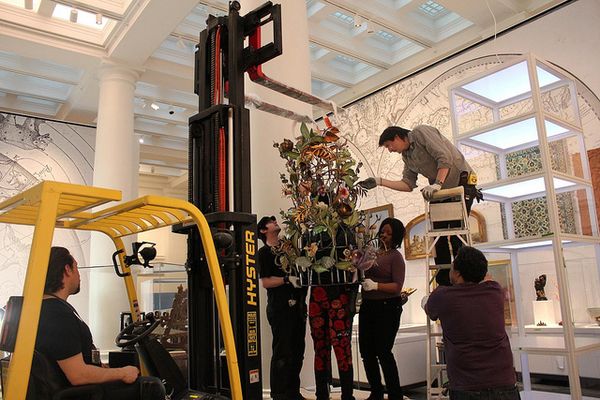Shifting the Paradigm in Connecting Cultures
Connecting Cultures, a new installation that includes works from the Brooklyn Museum’s many diverse collections, has now opened on the first floor in the Great Hall. For the first time, museum visitors will be presented with a taste of what is to come during their museum visit in an introductory gallery.

Art Handlers install Nick Cave's Soundsuit, 2008, one of several works by contemporary artists in the Connecting People section of Connecting Cultures. Soundsuit transforms the human body and allows the wearer to assume new identities by alluding to a range of rituals, from ceremonial African dances to Christian liturgy.
If you think about past visits to the Brooklyn Museum—or to any art museum, for that matter—you probably remember galleries divided into traditional categories. For instance, you might go to the Asian galleries or the African galleries, which are organized by geography. Or you might go to the ancient galleries or the contemporary galleries, which are organized by chronology or time; or you might visit paintings galleries or silver galleries, or period rooms, which are organized by medium or type. These organizational principles have been standard in museums for over a hundred years. We can learn a lot about objects and the cultures, eras and types they represent by seeing them organized in this way. But such a standard organization can also be limiting. It can prevent us from making new and exciting connections between geographical locations, time period and types of objects. It is these connections that often help us understand what it is to be human and how the arts express that.

Electricians test lighting in the wall of 90 pitchers in Connecting Cultures. These pitchers show the depth of the collections at the Brooklyn Museum and suggest what can be learned from assembling large numbers of objects together. The basic form of things is often defined by their purpose; pitchers, across time, place and cultures are meant first to hold liquid and then to pour it. As a result, pitchers have certain similarities no matter where or when they were made, but they also reveal, in their details, a great deal about their time and place.
So, Connecting Cultures breaks down traditional categories to challenge the viewer to see things in a new way and to make new connections. There are three very simple and straightforward themes in the installation—connecting people, connecting places, and connecting things. I hope that the new installation will do two things—first, introduce the visitor to the wide range of riches available at the Brooklyn Museum, and, second, stimulate some thinking about how to make connections between the museum galleries, as well as within them.
Many different themes could be developed using Connecting Cultures as a model: how does dance appear throughout time and among cultures; does the color blue mean the same thing in all cultures; how are concepts of death expressed in the arts? The possibilities are endless. Connecting Cultures can help us to begin to explore them.

Kevin Stayton was born in Ohio, and educated at the Ohio State University, and Yale University. He began work at the Brooklyn Museum in 1980 as an Assistant Curator of Decorative Arts. He became Curator of Decorative Arts in 1989, and Chief Curator in 2001. In addition to his position at the Brooklyn Museum, he has taught at the Bard Center for Studies in the Decorative Arts, Design and Culture; the Cooper-Hewitt/Parsons Graduate Program in the Decorative Arts; and Columbia University.
